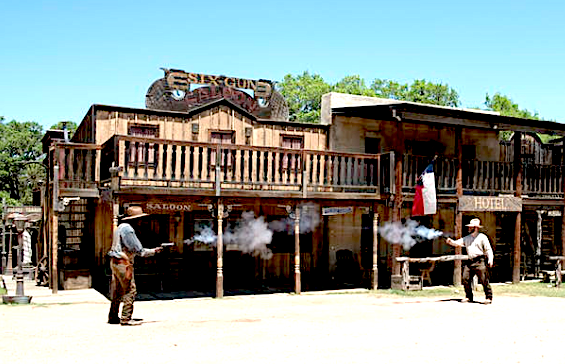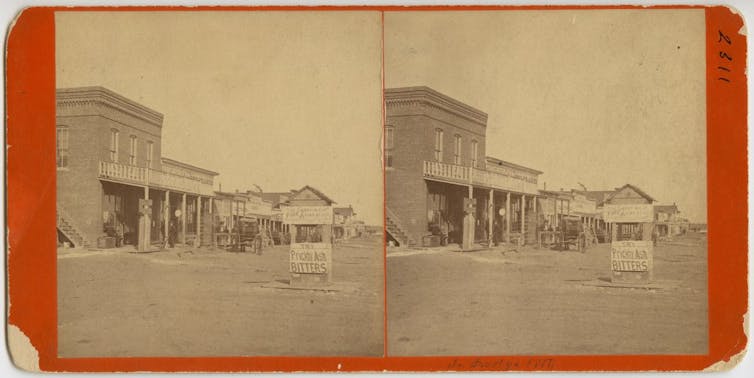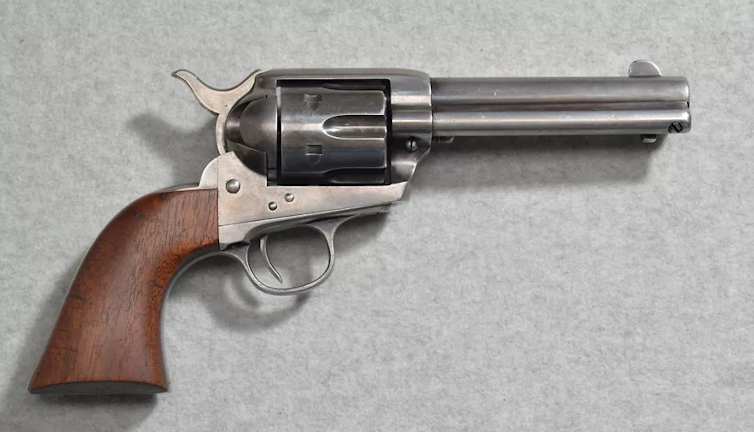Contrary to the imagery of the Wild West, Pierre M. Atlas says many towns in the real Old West had tougher restrictions on the carrying of guns than the one just invalidated by the Supreme Court.

Reenactments of Old West gunfights, like this one at a tourist attraction in Texas in 2014, are part of the mythology underpinning the United States’ gun culture. (Carol M. Highsmith via Library of Congress)
By Pierre M. Atlas
Indiana University
 In the wake of the Buffalo and Uvalde mass shootings, 70 percent of Republicans said it is more important to protect gun rights than to control gun violence, while 92 percent of Democrats and 54 percent of independents expressed the opposite view.
In the wake of the Buffalo and Uvalde mass shootings, 70 percent of Republicans said it is more important to protect gun rights than to control gun violence, while 92 percent of Democrats and 54 percent of independents expressed the opposite view.
Just weeks after those mass shootings, Republicans and gun rights advocates hailed the Supreme Court ruling that invalidated New York state’s gun permit law and declared that the Second Amendment guarantees a right to carry a handgun outside the home for self-defense.
Mayor Eric Adams, expressing his opposition to the ruling, suggested that the court’s decision would turn New York City into the “Wild West.” Contrary to the imagery of the Wild West, however, many towns in the real Old West had restrictions on the carrying of guns that were, I would suggest, stricter than the one just invalidated by the Supreme Court.
Support for gun rights among Republicans played an important role in determining the contents of the the bipartisan Safer Communities Act, the first new gun reform bill in three decades. President Joe Biden signed it into law just two days after the Supreme Court’s decision was released.
In order to attract Republican support, the new law does not include gun control proposals such as an assault weapons ban, universal background checks or raising the purchasing age to 21 for certain types of rifles.
Nevertheless, the bill was denounced by other Republicans in Congress and was opposed by the National Rifle Association.
I have found that for those Americans who see the gun as both symbolizing and guaranteeing individual liberty, gun control laws are perceived as fundamentally un-American and a threat to their freedom. For the most ardent gun rights advocates, gun violence – as horrible as it is – is an acceptable price of that freedom.
My analysis finds that gun culture in the U.S. derives largely from its frontier past and the mythology of the “Wild West,” which romanticizes guns, outlaws, rugged individualism and the inevitability of gun violence. This culture ignores the fact that gun control was widespread and common in the Old West.

Although hard to read, the sign to the right of this view of Dodge City, Kansas, from 1878 reads “The carrying of firearms strictly prohibited.” (Ben Wittick via Kansas Historical Society)
The Prevalence of Guns
Guns are part of a deep political divide in American society. The more guns a person owns, the more likely they are to oppose gun control legislation, and the more likely they are to vote for Republican candidates.
In 2020, 44 percent of American households reported owning at least one firearm. According to the 2018 international study Small Arms Survey, there were approximately 393 million firearms in civilian hands in the U.S., or 120.5 firearms per 100 people. That number is likely higher now, given increases in gun sales in 2019, 2020 and 2021.
Americans have owned guns since colonial times, but American gun culture really took off after the Civil War with the imagery, icons and tales – or mythology – of the lawless frontier and the Wild West.
Frontier mythology, which celebrates and exaggerates the amount and significance of gunfights and vigilantism, began with 19th-century Western paintings, popular dime novels and traveling Wild West shows by Buffalo Bill Cody and others. It continues to this day with Western-themed shows on streaming networks such as “Yellowstone” and “Walker.”
A gunfight in the TV show “Yellowstone.”
Marketing Move
Historian Pamela Haag attributes much of the country’s gun culture to that Western theme. Before the middle of the 19th century, she writes, guns were common in U.S. society, but were unremarkable tools used by a wide range of people in a growing nation.
But then gun manufacturers Colt and Winchester started marketing their firearms by appealing to customers’ sense of adventure and the romance of the frontier.
In the mid-19th century, the gun manufacturers began advertising their guns as a way people all around the country could connect with the excitement of the West, with its Indian wars, cattle drives, cowboys and gold and silver boomtowns. Winchester’s slogan was “The Gun That Won the West,” but Haag argues that it was really “the West that won the gun.”
By 1878, this theme was so successful that Colt’s New York City distributor recommended the company market the .44-40 caliber version of its Model 1873 single-action revolver as the “Frontier Six Shooter” to appeal to the public’s growing fascination with the Wild West.

Colt’s Frontier Six Shooter was marketed to take advantage of people’s romantic ideas of the Wild West. (Cabelas)
Different Reality
Gun ownership was commonplace in the post-Civil War Old West, but actual gunfights were rare. One reason was that, contrary to the mythology, many frontier towns had strict gun laws, especially against carrying concealed weapons.
As UCLA constitutional law professor Adam Winkler puts it, “Guns were widespread on the frontier, but so was gun regulation. … Wild West lawmen took gun control seriously and frequently arrested people who violated their town’s gun control laws.”
“Gunsmoke,” the iconic TV show that ran from the 1950s through the 1970s, would have seen far fewer gunfights had its fictional marshal, Matt Dillon, enforced Dodge City’s real laws banning the carrying of any firearms within city limits.
The appeal of this mythology extends to the present day. In August 2021, a Colt Frontier Six Shooter became the world’s most expensive firearm when the auction house Bonhams sold “the gun that killed Billy the Kid” at auction for over $6 million. As a mere antique firearm, that revolver would be worth a few thousand dollars. Its astronomic selling price was due to its Wild West provenance.
The historical reality of the American frontier was more complex and nuanced than its popular mythology. But it’s the mythology that fuels American gun culture today, which rejects the types of laws that were commonplace in the Old West.
Particular View of Safety & Freedom
Hardcore gun owners, their lobbyists and many members of the Republican Party refuse to allow the thousands of annual gun deaths and the additional thousands of nonfatal shootings to be used as justifications for restricting their rights as law-abiding citizens.
They are willing to accept gun violence as an inevitable side effect of a free and armed but violent society.
Their opposition to new gun reforms as well as the current trends in gun rights legislation – such as permitless carry and the arming of teachers – are but the latest manifestations of American gun culture’s deep roots in frontier mythology.
Wayne LaPierre, executive director of the National Rifle Association, the country’s largest gun rights group, tapped into imagery from frontier mythology and American gun culture following the Sandy Hook massacre in 2012. In his call to arm school resource officers and teachers, LaPierre adopted language that could have come from a classic Western film: “The only thing that stops a bad guy with a gun is a good guy with a gun.”
This view of a lone, armed person who can stand up and save the day has persisted ever since, and provides an answer of its own to mass shootings: Guns are not the problem – they’re the solution.![]()
Pierre M. Atlas is senior lecturer at the Paul H. O’Neill School of Public and Environmental Affairs, Indiana University.
This article is republished from The Conversation under a Creative Commons license. Read the original article.
The views expressed are solely those of the authors and may or may not reflect those of Consortium News.

Interesting contribution, but i can assure you from hundreds of conversations with working class men over the course of 50 years that the fantasy of standing up to government tyranny and the expectation of civil warfare are central motives. Wild West fantasies appear to be derivative, rationalizations.
In the realm of mythology, there is also – and perhaps more significantly – the peculiarly American equation of revolution with armed rebellion, rooted in the schoolbook history that jumps from the Boston Tea Party to Paul Revere’s Ride and Lexington/Concord – skipping over the actual non-violent popular revolution that happened in the year-and a-half in between. (See worcesterrevolutioon1774.com or .org for more about this profound but largely forgotten event that shaped our history.)
Most working men in my experience, given enough time to summon up what they know about how things work in America and to express their views, will come up with some version of “you know what? We need a revolution!” (Often half-whispered. ). But the next step in that chain is “but a revolution means war and bloodshed.” Which usually stops the conversation.
Thus paradoxically owning guns is on the one hand preparation for what many see as an inevitable civil conflict, and on the other an anchor for their confusion about revolution and their reluctance to get involved in the kinds of nonviolent mass struggles around the injustices and privations that confront them and their communities which could lead to a real people’s revolution. It also leaves them prey to those who offer easy answers to who their enemy really is and who their leaders are, who will call them to battle with some version of “the Redcoats are coming!”
There is the further part that guns play in family dynamics, and as a rationale for the militarization of our police forces. I won’t add anything about that here except to insist that both are real, and are further reasons not to reduce our understanding of the motives of our gun culture to some aspect of our mythology.
Thanks for this informative article. It’s also often overlooked that so many of the legendary outlaws of the Old West were veterans who were affected by what we would call PTSD from their service in the War for the Union, as well as those who discovered a taste for bloodshed while engaged as “irregulars” in that terrible struggle. Before mass production, firearms were owned by relatively few, being handmade by gunsmiths and expensive. Samuel Colt devised the first mass production process for gun manufacture in the 1830s but he went broke because few were interested in buying them. Men, again, became accustomed to carrying firearms during the Civil War. In early times too black powder was unstable and unsafe to keep in people’s homes. Generally, shot and powder were ordered by municipal ordinances to be stored in town facilities. Most of our older cities still have streets named Powderhouse or Magazine in testimony to this forgotten tradition.
Also if you read the debates in Congress on the first ten amendments (whittled down from the original 125 proposals) you’ll find nothing in the debates of Number 7 (now our 2nd Amendment) about politicians proposing to arm the common people against them, in case they got too overbearing! The topics discussed were the circumstances under which the militias would be called out, whether state or federal officers would command them, and the all-important question of who would pay the costs. Within two years of approval, in 1793, the Second Amendment got its first workout when a large militia host, commanded by President Washington himself, was mustered to intimidate tax protestors in the Whiskey Rebellion. There has never been a case in our history where armed citizen militias rose spontaneously against the government. Even the insurrectionists of 1861 were acting under the command of those state authorities who chose not to accept losing a free presidential election.
“It is entirely possible that [Pamela] Haag’s book has some value with respect to understanding the development of industrial gun manufacturing and distribution. But anyone citing this book in a brief should be aware that it is built on a clearly false presupposition.”
Source:
Clayton E. Cramer, “Bellesiles’ ‘Arming America’ Redux: Does the Gunning of America Rewrite American History to Suit Modern Sensibilities?,” 41 S. Ill. U. L.J. 403-338 (2017), available at papers.ssrn.com/sol3/papers.cfm?abstract_id=2789895
In the uncovering of the frontier mythology, I would recommend the book The Imperial Cruise by James Bradley,
and his excellent expose of one of the greatest frauds in American history – the evil Theodore Roosevelt.
It is certainly absurd to think that a nation whose entire foreign policy is premised upon military might is somehow going to show great restraint in domestic “arms control.” We “live by the sword,” and thus we shall continue to “die by the sword.” I am glad to learn what I did not know–that the wild west wasn’t as wild as the myth that persists, though I’m not a bit surprised. Marketing again takes its toll on the American psyche. We buy fantasy over and over and over, including the fantasy that guns make us safe–bombs secure our peace.
How did gun confiscation work out in Germany and Poland in the 1930’s?
Well-said! As I heard one pundit say (paraphrasing), ‘The US was settled/founded by gold-seekers and religious zealots’, and I believe those are big factors in our current culture, along with our relatively isolated geographic location and comparative youth. They’ve been instilled into our cultural DNA and common-sense/rational thought is a distant second when it comes to problem solving, more-so than in most European/western states.